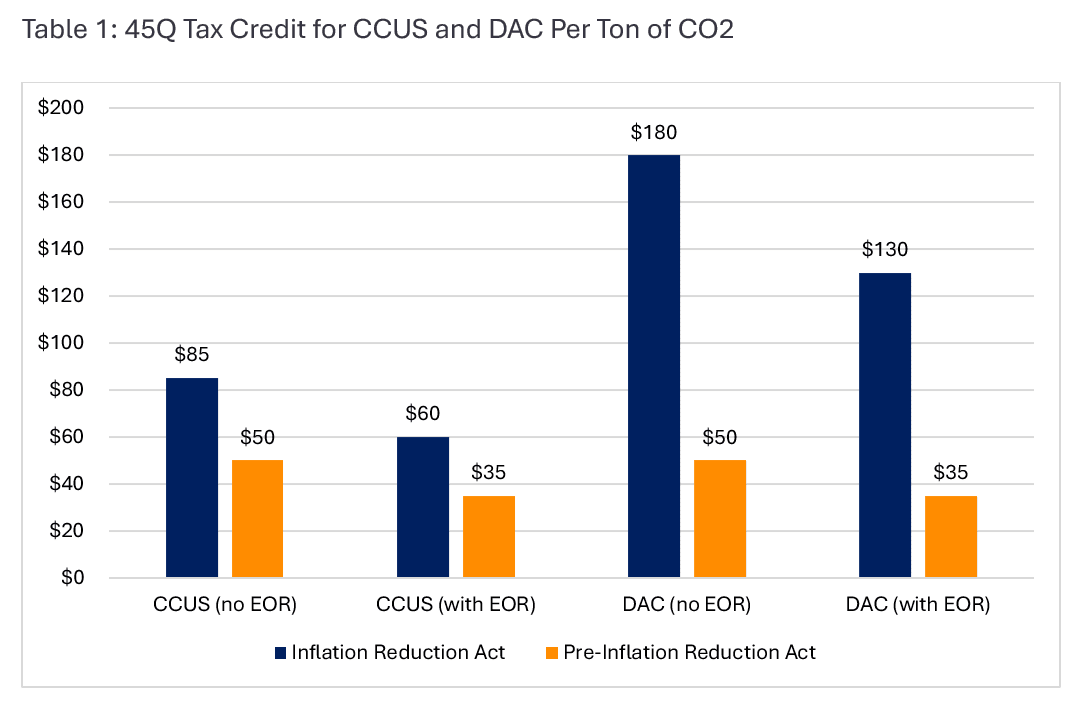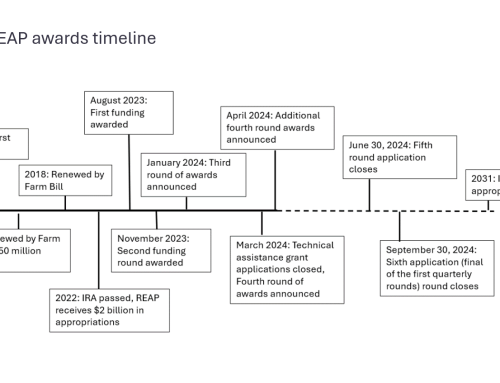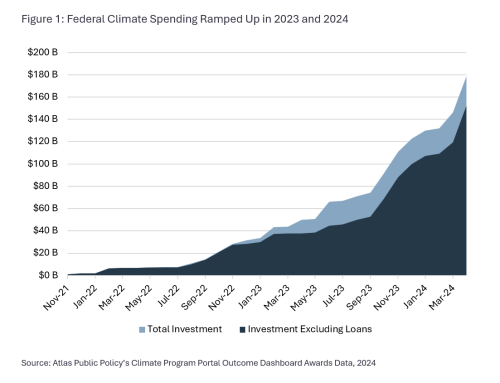
Overview of CCUS and DAC
Carbon capture, usage (or utilization) and storage (CCUS) and direct air capture (DAC) are the two primary non-natural methods for capturing and sequestering atmospheric carbon dioxide. The two systems differ primarily in that CCUS captures CO2 at the source of the emissions, whereas DAC plants capture ambient CO2 in the atmosphere. In both systems, the end product is concentrated carbon dioxide gas, which can be used for processes such as enhanced oil recovery (EOR), where it is used to extract oil, and/or sequestered underground for long-term storage. There are also other methods of long-term carbon storage, such as tree planting or seaweed growth, but they did not receive considerable support in IIJA and IRA.
Challenges and Risks
There are risks and challenges with the adoption of CCUS and DAC technologies. Both are somewhat controversial for several reasons. Many see the technologies as enabling continued pollution by fossil fuel companies by serving as an offset or a distraction, rather than encouraging a transition to clean energy. There are also environmental justice concerns about where DAC plants, pipelines, and injection sites will be located, as there is a risk of leakage that could impact communities which have already been harmed by the extractive fossil fuel economy. Importantly, CO2 for permanent sequestration is generally mixed with water and then injected, while CO2 for EOR is generally liquified and highly compressed, and therefore significantly more dangerous in the event of a leak as a toxin in the air.
However, according to some models, including from the Intergovernmental Panel on Climate Change, even in a future of no additional carbon emissions, carbon capture in some form will be essential in fighting climate change. We have now emitted enough CO2 that a fully clean global energy system tomorrow (unlikely as things stand) would not stop the warming effect. Therefore, technology to remove CO2 will be necessary, even if we stop emitting it. Accordingly, the Biden Administration, via the Infrastructure Investment and Jobs Act (IIJA) and the Inflation Reduction Act (IRA), has allocated funding to developing these technologies to scale them and lower costs.
The use of captured CO2 for EOR is another challenge. The risk with this funding is that it may subsidize otherwise unprofitable oil production, undermining climate objectives. However, the use of CO2 for many decades as a tool for EOR has given us data that is useful for planning wider-scale long-term storage. The most successful sequestration processes involve the CO2 mineralizing (transformation into rock upon interaction with the base rock layer) in the span of about two years, trapping it permanently and rendering leaks impossible. Newly funded regional DAC hubs, as well as the funding for permitting locations and standards, should tell us more about mineralization opportunities in the United States.
Both Acts contain funding for carbon sequestration, sourced from both CCUS and DAC. Most significantly, they support the increase of the 45Q tax credit, the development of regional DAC hubs, changes in permitting permissions for the injection of CO2 and the Carbon Storage Validation and Testing program. We track these programs on the Climate Program Portal.
45Q
There is only one program dedicated to carbon capture in the IRA, but it is a key one: the expansion of the 45Q tax credit. 45Q grants tax credits for permanent sequestration as well as for CO2 use in enhanced oil recovery, putting a value on carbon removal and improving the economics of sequestration without taxing carbon emissions. The credit was originally enacted in 2008 by the Bush administration, but the IRA increases the dollar amount per ton and extends the time frame and size of projects that qualify for the credit. This change in the credit amount sequestered is the most significant, although it differentiates the dollars per ton received based on source and end use of the CO2, as seen in the graph above.
The increase is particularly large for DAC projects. DAC currently costs between $200 – $600 per ton of CO2, so these numbers make an enormous difference in the profitability of DAC for private companies. IRA also changed the threshold for the amount of CO2 captured to qualify for the benefit, lowering it from 100,000 tons to just 1,000 for DAC, and from 25,000 tons to 12,500 for CCUS. This will allow smaller DAC pilot projects to benefit from the credit, as well as smaller and lower-emitting industrial facilities using CCUS.
Though the inclusion of EOR is not universally popular, it is worth noting that oil producers already use CO2 regularly for EOR, but from terrestrial sources (they dig it up and inject it again to get the oil out). Incentivizing the use of captured CO2 for EOR makes it more likely that producers will use it rather than emitting even more from terrestrial sources. Approximately 90-95 percent of CO2 gas used in EOR remains permanently sequestered after use. Whether this balances emissions from extraction depends on how and when you calculate them, as well as the efficiency of the extraction process. Generally, EOR projects are carbon negative earlier on, but the longer they go, the more inefficient they become. If the long-term federal goal is to transition away from fossil fuels, then the EOR credit should not last as long as its sequestration counterpart.
DAC Hubs
IIJA has several items that focus on sequestration, including funding for four DAC research hubs, pilot and demonstration projects, and research into underground storage of CO2. The building out of regional DAC hubs funded in IIJA will be important for developing the technology, which is still costly and uncommon. The Act grants $3.5 billion from FY2022-2026 for four regional hubs. Already two DAC companies, Climeworks and Heirloom, have applied together for $500 million to build a hub in the Gulf Coast region. The DOE has not said how many other applications they have received. All four hubs will feature facilities for the capture, transport, and storage of CO2, and once established are expected to capture one million tons of CO2 annually each. These hubs will provide key research on geologic sequestration methods, locations, and monitoring practices, as well as greatly increase economies of scale for the production of the specific plant parts needed for DAC. Until now, because there are only 18 DAC pilot or demonstration sites worldwide, these parts have been bespoke and expensive.
Thus far on the Climate Program Portal Dashboard, there has been one notice of intent (NOI) released in May 2022 focusing on the regional hubs. This is the only announced or released funding relating specifically to DAC as of May 2023.
Permitting
IIJA increases the funding to the EPA for the permitting of new wells for CO2 injection, as well as funding to states to develop their own “primacy” (the ability to permit Class VI wells to EPA standards without federal input) through the “Underground Injection Control Grants: Class VI wells” program. Total appropriated funding for permitting issues amounts to $75 million, a comparatively small amount that belies the importance of this change. Injection of CO2 underground falls under EPA Class VI well permitting and was previously a significant bottleneck in the acceleration of CO2 sequestration nationwide. Injection permits could take up to six years to approve, due to lack of institutional knowledge and delays in gaining legal permissions. These adjustments will allow for planning for larger-scale sequestration operations and pave the way for demonstration projects. They also lower the cost of an individual project to a company, as permitting will be more streamlined and less labor-intensive.
Carbon Storage Validation and Testing
On May 17th 2023, the Department of Energy announced $251 million in funding for 12 CO2 transportation and storage projects. The majority of the projects focus on permitting and siting for CO2 transport and storage infrastructure tied to a larger capture projects. The projects, featured in Table 1, are a mix of DAC and CCUS. Houston is home to five of the projects (BP is funded for two projects), which together will receive nearly $100 million of the total funding.

Other Key Carbon Sequestration Programs
There are other programs from IIJA and IRA relating to carbon sequestration, some more tangentially than others. You can track these on the Climate Program Portal by searching for the tag, Carbon Capture and Sequestration, as in the image below.
These programs include several programs for research on underground storage and transportation infrastructure for captured CO2, both of which are essential to the creation of a meaningfully large carbon capture ecosystem. Additionally, the Geologic Carbon Sequestration on the Outer Continental Shelf program focuses on oceanic carbon storage, opening another route for permanent storage far from residential dwellings. Agencies are at work with implementation. In February 2023, a funding opportunity announcement was released for full-scale CCUS pilot projects. The announcement makes $820 million available from the “Carbon Capture Large Scale Pilot Programs” program, with up to 70 percent federal cost share available for up to 10 pilot projects. Applications for a concept paper closed in April 2023.
Taken together, these programs and the rollout of funding mark the beginning of serious federal support for carbon capture and sequestration. Whether those dollars will end up greenwashing heavy industry or form an important pillar in climate change mitigation will depend, as usual, on successful implementation.



